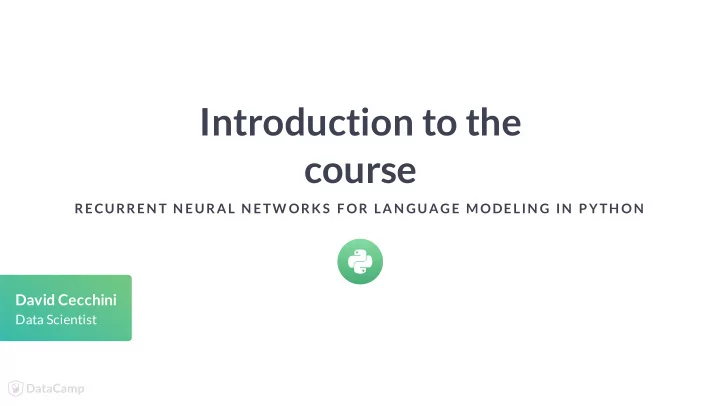

Introduction to the course RECURREN T N EURAL N ETW ORK S F OR LAN GUAGE MODELIN G IN P YTH ON David Cecchini Data Scientist
Text data is available online RECURRENT NEURAL NETWORKS FOR LANGUAGE MODELING IN PYTHON
Applications of machine learning to text data Four applications: Sentiment analysis Multi-class classi�cation T ext generation Machine neural translation RECURRENT NEURAL NETWORKS FOR LANGUAGE MODELING IN PYTHON
Sentiment analysis RECURRENT NEURAL NETWORKS FOR LANGUAGE MODELING IN PYTHON
Multi-class classi�cation RECURRENT NEURAL NETWORKS FOR LANGUAGE MODELING IN PYTHON
Text generation RECURRENT NEURAL NETWORKS FOR LANGUAGE MODELING IN PYTHON
Neural machine translation RECURRENT NEURAL NETWORKS FOR LANGUAGE MODELING IN PYTHON
Recurrent Neural Networks RECURRENT NEURAL NETWORKS FOR LANGUAGE MODELING IN PYTHON
Sequence to sequence models Many to one: classi�cation RECURRENT NEURAL NETWORKS FOR LANGUAGE MODELING IN PYTHON
Sequence to sequence models Many to many: text generation RECURRENT NEURAL NETWORKS FOR LANGUAGE MODELING IN PYTHON
Sequence to sequence models Many to many: neural machine translation RECURRENT NEURAL NETWORKS FOR LANGUAGE MODELING IN PYTHON
Sequence to sequence models Many to many: language model RECURRENT NEURAL NETWORKS FOR LANGUAGE MODELING IN PYTHON
Let's practice! RECURREN T N EURAL N ETW ORK S F OR LAN GUAGE MODELIN G IN P YTH ON
Introduction to language models RECURREN T N EURAL N ETW ORK S F OR LAN GUAGE MODELIN G IN P YTH ON David Cecchini Data Scientist
Sentence probability Many available models Probability of "I loved this movie". Unigram P (sentence) = P (I) P (loved) P (this) P (movie) N-gram N = 2 (bigram): P (sentence) = P (I) P (loved∣I) P (this∣loved) P (movie∣this) N = 3 (trigram): P (sentence) = P (I) P (loved∣I) P (this∣I loved) P (movie∣loved this) RECURRENT NEURAL NETWORKS FOR LANGUAGE MODELING IN PYTHON
Sentence probability (cont.) Skip gram P (sentence) = P (context of I∣I) P (context of loved∣loved) P (context of this∣this) P (context of movie∣movie) Neural Networks The probability of the sentence is given by a softmax function on the output layer of the network RECURRENT NEURAL NETWORKS FOR LANGUAGE MODELING IN PYTHON
Link to RNNs Language models are everywhere in RNNs! The network itself RECURRENT NEURAL NETWORKS FOR LANGUAGE MODELING IN PYTHON
Link to RNN (cont.) Embedding layer RECURRENT NEURAL NETWORKS FOR LANGUAGE MODELING IN PYTHON
Building vocabulary dictionaries # Get unique words unique_words = list(set(text.split(' '))) # Create dictionary: word is key, index is value word_to_index = {k:v for (v,k) in enumerate(unique_words)} # Create dictionary: index is key, word is value index_to_word = {k:v for (k,v) in enumerate(unique_words)} RECURRENT NEURAL NETWORKS FOR LANGUAGE MODELING IN PYTHON
Preprocessing input # Initialize variables X and y X = [] y = [] # Loop over the text: length `sentence_size` per time with step equal to `step` for i in range(0, len(text) - sentence_size, step): X.append(text[i:i + sentence_size]) y.append(text[i + sentence_size]) # Example (numbers are numerical indexes of vocabulary): # Sentence is: "i loved this movie" -> (["i", "loved", "this"], "movie") X[0],y[0] = ([10, 444, 11], 17) RECURRENT NEURAL NETWORKS FOR LANGUAGE MODELING IN PYTHON
Transforming new texts # Create list to keep the sentences of indexes new_text_split = [] # Loop and get the indexes from dictionary for sentence in new_text: sent_split = [] for wd in sentence.split(' '): ix = wd_to_index[wd] sent_split.append(ix) new_text_split.append(sent_split) RECURRENT NEURAL NETWORKS FOR LANGUAGE MODELING IN PYTHON
Let's practice! RECURREN T N EURAL N ETW ORK S F OR LAN GUAGE MODELIN G IN P YTH ON
Introduction to RNN inside Keras RECURREN T N EURAL N ETW ORK S F OR LAN GUAGE MODELIN G IN P YTH ON David Cecchini Data Scientist
What is keras? High-level API Can use T ensor�ow, CNTK or Theano frameworks Easy to install and use $pip install keras Fast experimentation: from keras.models import Sequential from keras.layers import LSTM, Dense RECURRENT NEURAL NETWORKS FOR LANGUAGE MODELING IN PYTHON
keras.models keras.models.Sequential keras.models.Model RECURRENT NEURAL NETWORKS FOR LANGUAGE MODELING IN PYTHON
keras.layers 1. LSTM 2. GRU 3. Dense 4. Dropout 5. Embedding 6. Bidirectional RECURRENT NEURAL NETWORKS FOR LANGUAGE MODELING IN PYTHON
keras.preprocessing keras.preprocessing.sequence.pad_sequences(texts, maxlen=3) RECURRENT NEURAL NETWORKS FOR LANGUAGE MODELING IN PYTHON
keras.datasets Many useful datasets IMDB Movie reviews Reuters newswire And more! For a complete list and usage examples, see keras documentation RECURRENT NEURAL NETWORKS FOR LANGUAGE MODELING IN PYTHON
Creating a model # Import required modules from keras.models import Sequential from keras.layers import Dense # Instantiate the model class model = Sequential() # Add the layers model.add(Dense(64, activation='relu', input_dim=100)) model.add(Dense(1, activation='sigmoid')) # Compile the model model.compile(optimizer='adam', loss='mean_squared_error', metrics=['accuracy']) RECURRENT NEURAL NETWORKS FOR LANGUAGE MODELING IN PYTHON
Training the model The method .fit() trains the model on the training set model.fit(X_train, y_train, epochs=10, batch_size=32) 1. epochs determine how many weight updates will be done on the model 2. batch_size size of the data on each step RECURRENT NEURAL NETWORKS FOR LANGUAGE MODELING IN PYTHON
Model evaluation and usage Evaluate the model : model.evaluate(X_test, y_test) [0.3916562925338745, 0.89324] Make predictions on new data : model.predict(new_data) array([[0.91483957],[0.47130653]], dtype=float32) RECURRENT NEURAL NETWORKS FOR LANGUAGE MODELING IN PYTHON
Full example: IMDB Sentiment Classi�cation # Build and compile the model model = Sequential() model.add(Embedding(10000, 128)) model.add(LSTM(128, dropout=0.2)) model.add(Dense(1, activation='sigmoid')) model.compile(loss='binary_crossentropy', optimizer='adam', metrics=['accuracy']) # Training model.fit(x_train, y_train, epochs=5) # Evaluation score, acc = model.evaluate(x_test, y_test) RECURRENT NEURAL NETWORKS FOR LANGUAGE MODELING IN PYTHON
Time to practice! RECURREN T N EURAL N ETW ORK S F OR LAN GUAGE MODELIN G IN P YTH ON
Recommend
More recommend